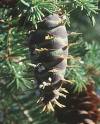Pseudotsuga Menziesii Var Menziesii Tree Information
Images of Pseudotsuga Menziesii Var Menziesii:






Pseudotsuga Menziesii Var Menziesii grows in the following 5 states and provinces:
British Columbia, California, Hawaii, Oregon, WashingtonInformation about Pseudotsuga Menziesii Var Menziesii:
The Pseudotsuga Menziesii Var. Menziesii is commonly known as the Coast Douglas-fir, Douglas-fir as well as Oregon Douglas-fir.
The currently accepted scientific name of Douglas-fir is Pseudotsuga menziesii (Mirb.) Franco . Two varieties are recognized, based on foliage color, cone form, growth rate, and environmental requirements : var. menziesii - coast Douglas-fir, the "green" variety, is indigenous west of the Sierra Nevada and Cascade Mountains var. glauca (Beissn.) Franco - Rocky Mountain Douglas-fir, the "blue" variety, is native to the Rocky Mountains and interior mountains of the Pacific Northwest Information reported here is for coast Douglas-fir only. Rocky Mountain Douglas-fir is described in a separate FEIS review. Coast Douglas-fir grows from west-central British Columbia southward to central California. In Oregon and Washington its range is continuous from the Cascades west to the Pacific Ocean. In California, it is found in the Klamath and Coast ranges as far south as the Santa Cruz Mountains, and in the Sierra Nevada as far south as the Yosemite Region . Rocky Mountain Douglas-fir occurs east of the Sierra Nevada and Cascade Mountain Ranges.Seral coast Douglas-fir communities dominate much of the western hemlock (Tsuga heterophylla) and Pacific silver fir (Abies amabilis) zones of western Washington and Oregon . Climax Douglas-fir forests are rare in the northern and central Cascades, and are restricted to hot, dry sites which commonly occur on south- or southwest-facing slopes at low elevations . Climax Douglas-fir forests increase southward from central Oregon. In southwestern Oregon and northern California, Douglas-fir is a widespread climax dominant or codominant. It is probably the most abundant tree in the mixed-conifer zone, but its abundance tends to decrease and that of ponderosa pine (Pinus ponderosa) increase north to south within this zone . Associates in the mixed-conifer zone include ponderosa pine, sugar pine (P. lambertiana), incense-cedar (Calocedrus decurrens), and white fir (Abies concolor) . In the mixed-evergreen zone, Douglas-fir dominates at climax with tanoak (Lithocarpus densiflorus), Pacific madrone (Arbutus menziesii), canyon live oak (Quercus chrysolepis), giant chinquapin (Chrysolepsis chrysophylla), sugar pine, ponderosa pine, and incense-cedar . Published classifications listing coast Douglas-fir as a dominant in cover types, community types (cts), or plant associations (pas) are listed below: Area Classification Authority WA: North Cascades NP forest cover types Agee & Kertis 1987 WA: Olympic Mtns forest cts Fonda & Bliss 1969 WA: Mount Rainier NP forest cts Franklin & others 1988 WA: Gifford Pinchot NF western hemlock pas Topik & others 1986 WA: Gifford Pinchot NF grand fir pas Topik 1989 OR, WA general veg. cts Franklin & Dyrness 1973 OR: Willamette NF general veg. pas Hemstrom & others 1987 OR: Winema NF general veg. pas Hopkins 1979 s OR: Cascade Mtns general veg. pas Atzet & McCrimmon 1990 OR, CA: Siskiyou Mtns general veg. pas Atzet & Wheeler 1984 CA mixed evergreen Sawyer & others 1977 forest cts CA Redwood & north Zinke 1977 Coast forest ctsSome of the information provided here is attributed to:Uchytil, Ronald J. 1991. Pseudotsuga menziesii var. menziesii. In: Fire Effects Information System, [Online]. U.S. Department of Agriculture, Forest Service, Rocky Mountain Research Station, Fire Sciences Laboratory (Producer). , available at the USDA Fire Effects Information System (FEIS) website